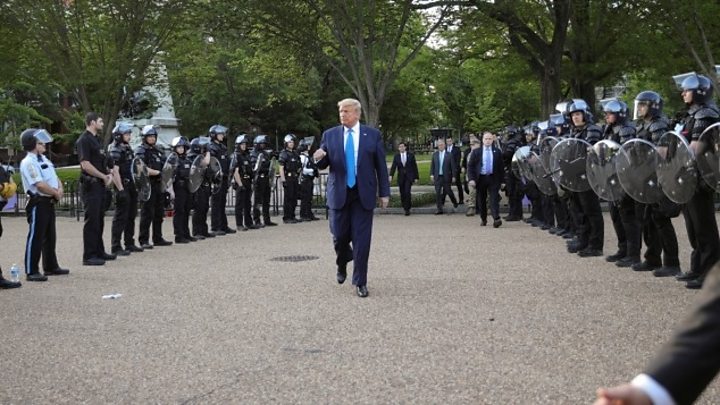US President Donald Trump has threatened to send in the military to quell growing civil unrest over the death of a black man in police custody.
He said if cities and states failed to control the protests and "defend their residents" he would deploy the army and "quickly solve the problem for them".
The death of George Floyd, 46, in Minneapolis on 25 May triggered an outpouring of anger across the country.
Major cities have implemented curfews as the unrest enters its seventh day.
New York City has imposed a citywide lockdown until 05:00 on Tuesday. Washington DC, meanwhile, has extended its curfew for another two nights.
But the demonstrations are expected to continue. They began after a video showed Mr Floyd being arrested and a white police officer continuing to kneel on his neck even after he pleaded that he could not breathe.
The officer, Derek Chauvin, has been charged with third-degree murder and manslaughter and will appear in court next week. Three other police officers have been fired.
On Monday, an official post-mortem examination declared Mr Floyd's death a homicide.
What did Trump say?
The president delivered a brief address from the White House Rose Garden on Monday evening, and it was marked by the sound of a nearby protest being dispersed with tear gas and rubber bullets.
He said "all Americans were rightly sickened and revolted by the brutal death of George Floyd" but said his memory must not be "drowned out by an angry mob".

Media playback is unsupported on your device
Mr Trump described the scenes of looting and violence in the capital on Sunday as "a total disgrace" before pledging to bolster the city's defences.
"I am dispatching thousands and thousands of heavily armed soldiers, military personnel and law enforcement officers to stop the rioting, looting, vandalism, assaults and the wanton destruction of property," he said.
Mr Trump then turned his attention to the national protests, which he blamed on "professional anarchists" and the anti-fascist group Antifa. On Sunday, he designated Antifa as a terrorist organisation.
He called on cities and states to deploy the National Guard, the reserve military force that can be called on to intervene in domestic emergencies, "in sufficient numbers that we dominate the streets". About 16,000 of its troops have been deployed to deal with the unrest so far.
Mr Trump added: "If a city or state refuses to take the actions that are necessary... then I'll deploy the United States military and quickly solve the problem for them."
"I want the organisers of this terror to be on notice that you'll face severe criminal penalties," he said.
His comments were met with swift criticism from senior Democrats. Joe Biden, the party's presumptive presidential candidate, said Mr Trump [was] using the American military against the American people".
Senate Minority Leader Chuck Schumer said: "How low can this president go?... His actions reveal his true nature."
An escalation of force?
Throughout Monday, pressure grew on Donald Trump to take action to address the rising unrest in major cities across the US. As the sun set in Washington DC, in a hastily arranged Rose Garden address, the president outlined what that action would be.
Governors were warned that if they did not effectively secure property and safety on the streets, the president would cite a centuries-old law to dispatch the US Army on American soil. And in the District of Columbia, which is under federal authority, the president had already ordered the military to deploy in force.
Moments before the president spoke, promising he was on the side of peaceful protesters, those armed soldiers cleared out peaceful protesters from Lafayette Square, across the street from the White House.
It set the stage for the president to walk with his senior staff across the park to St John's Church, which was lightly damaged in a fire set by rioters the previous evening - an important symbolic gesture or an unnecessary photo opportunity, depending on one's perspective. Posing in front of the building with a Bible, he promised that America was "coming back strong" and "it won't take long".
There was no talk of police reforms or the root causes of the protests that began last week at any point in the evening's proceedings. Instead, he said he was the "president of law and order" - a sign, it seems, that his solution to the ongoing crisis will be an escalation of force.
What's the latest with the protests?
More than 75 cities have seen protests over what happened to George Floyd. Streets that only days ago were deserted because of the coronavirus pandemic have filled with demonstrators marching shoulder to shoulder.
Protests kicked off for another evening on Monday. More than 40 cities have imposed or extended their curfews.

Media playback is unsupported on your device
On Sunday, mostly peaceful demonstrations once again gave way to violence in many cities, with clashes erupting between police and protesters.
Police cars were burned, buildings were torched and shops looted in several places. Dozens of cities imposed curfews but they were defied.
Many videos shared on social media from across the US appeared to show riot police responding disproportionately to demonstrators. Dozens of attacks targeting journalists have been reported.
And the chief of Louisville Police in Kentucky was fired after law enforcement shot into a crowd, killing the owner of a nearby business.
Mayor Greg Fischer said officers and troops involved in the shooting failed to activate body cameras. "This type of institutional failure will not be tolerated," he said.
https://news.google.com/__i/rss/rd/articles/CBMiM2h0dHBzOi8vd3d3LmJiYy5jby51ay9uZXdzL3dvcmxkLXVzLWNhbmFkYS01Mjg4NjczNtIBN2h0dHBzOi8vd3d3LmJiYy5jby51ay9uZXdzL2FtcC93b3JsZC11cy1jYW5hZGEtNTI4ODY3MzY?oc=5
2020-06-02 02:03:29Z
CBMiM2h0dHBzOi8vd3d3LmJiYy5jby51ay9uZXdzL3dvcmxkLXVzLWNhbmFkYS01Mjg4NjczNtIBN2h0dHBzOi8vd3d3LmJiYy5jby51ay9uZXdzL2FtcC93b3JsZC11cy1jYW5hZGEtNTI4ODY3MzY
Tidak ada komentar:
Posting Komentar